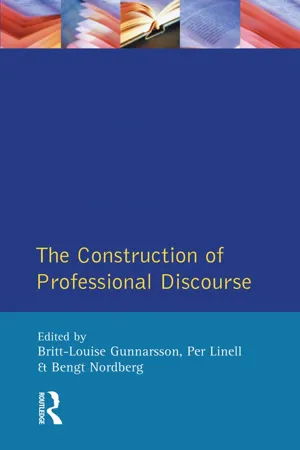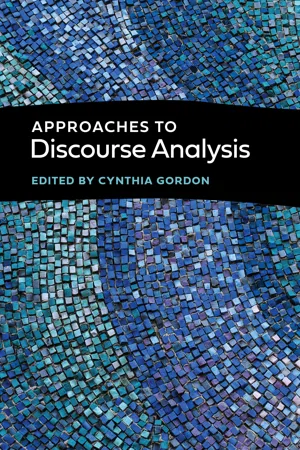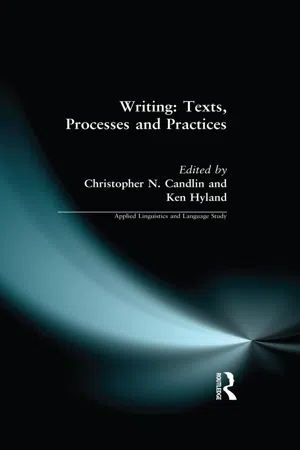Drew and Heritage Institutional Talk
The "Drew and Heritage Institutional Talk" refers to a type of conversation analysis that focuses on the interactional practices within institutional settings. It examines how participants in institutional talk manage their roles, responsibilities, and power dynamics through language use. This approach sheds light on the ways in which language shapes and reflects social structures and relationships within institutional contexts.
7 Key excerpts on "Drew and Heritage Institutional Talk"
- eBook - ePub
- Almut Koester(Author)
- 2006(Publication Date)
- Routledge(Publisher)
...It will not be possible to cover all these types of interaction in any kind of detail, but this chapter attempts to provide an overview of previous research in this area and of the kind of discourse that has been investigated. But first we need to examine what is distinctive about workplace discourse, and why it warrants special investigation. 1.2.1 The characteristics of institutional talk The term ‘institutional talk’ is frequently used in the literature to refer to interactions in all kinds of workplace setting. Institutional talk differs from ordinary conversation in a number of ways (Drew and Heritage 1992:3–65, Schegloff 1992a, Heritage 1997). According to Drew and Heritage (1992:22), the distinctiveness of institutional discourse is reflected in three dimensions of interaction: 1 Goal orientation : ‘an orientation by at least one of the participants to some core goal, task or identity … conventionally associated with the institution.’ 2 ‘ Special and particular constraints on what one or both of the participants will treat as allowable contributions to the business at hand.’ 3 ‘ Inferential frameworks and procedures that are particular to specific institutional contexts.’ Participants’ goal orientation is reflected in a number of features of workplace talk, for example in the recurrence of particular types of discursive activity which can be associated with specific workplace practices, such as instruction-giving, decision-making, briefing. Institutional encounters may also have an overall structural organization consisting of a number of phases, each of which plays a particular role in terms of the overall goal of the encounter. It is noticeable that task-oriented talk tends to be more structured than talk in which participants are not focused on a workplace task...
- eBook - ePub
- Harry Daniels, Harry Daniels(Authors)
- 2017(Publication Date)
- Routledge(Publisher)
...This is, Schegloff argues, in itself an analysis of social structure and interaction. Within conversation analysis, various forms of institutional talk have been analyzed as systematic variations of some basic features of ‘ordinary talk’ (Drew and Heritage 1992; Schegloff 1992a, 1992b). Analysts within the conversation analysis tradition claim that ‘it is often possible to recognize the “institutional” character of sequences of talk without any information beyond the words on the page’ (Heritage 1984: 283). The position that the institutionality of talk can be derived from the words on the page has consequences at many levels. For instance, it can be argued that the analyst does not need to know very much about the particular institutional practice under scrutiny in order to be able to analyze it. Ethnographic detail and contextual knowledge might even interfere with the ambition to understand talk-in-interaction. Recently, Hester and Francis (2000) launched an attack on the attempts to import conversation analysis perspectives into the analysis of institutional talk. They, very convincingly in our opinion, demonstrate that in several paradigmatic conversation analysis-inspired studies and analyses of institutional communication, the contexts of the utterances (a medical clinic, a news interview setting and so on) feature as resources for the analyst when making claims about interaction, even though this is not explicitly recognized in the analysis. Hester and Francis conclude by saying that the ‘claim that conversational structures comprise a “bedrock” for institutional ones’ by proponents of conversation analysis, ‘effectively desensitizes analysts from the local specifics of ‘’institutional’’ interaction’...
- eBook - ePub
The Discourse of Reading Groups
Integrating Cognitive and Sociocultural Perspectives
- David Peplow, Joan Swann, Paola Trimarco, Sara Whiteley(Authors)
- 2015(Publication Date)
- Routledge(Publisher)
...We discuss this further below. We draw particularly on the work of the conversation analyst John Heritage (2004), as well as other conversation analytic studies that have sought to understand institutional discourse. Heritage offered a three-part definition of this form of talk: it normally involves participants in specific goal orientations associated with their institutionally-relevant identities: doctor and patient, teacher and pupil, etc it involves special constraints on what will be treated as allowable contributions to the business at hand it is associated with inferential frameworks and procedures that are particular to specific institutional contexts. (Heritage 2004: 224–225) We begin by examining these features. 5.1.1 Institutional Discourse and ‘Goal Orientation’ Reading group meetings, like, for instance, workplace and other professional meetings, have a specific goal or purpose: the discussion of one or more literary texts, tied to group members’ identities as particular types of reader. There are differences between reading groups in their level of explicit commitment to this process, and group members themselves comment on this issue in relation to their own and other groups. We mentioned in Chapter 4 a group member referring to her membership of both a ‘friendly discussion’ and a more ‘serious debate’ group, and similar contrasts occur in other interviews. Extract 5.1 comes from a group interview with the Orchards group, a group last discussed in Chapter 3. One member, Alex, also attends another reading group that she says is similar to the Orchards group. She contrasts these with a group attended by a friend of hers. Extract 5.1 Orchards group: Being ‘focused on the book’ In the interview, Alex’s friend’s group is presented as being rather lightweight, taking tea and cake and without ‘much book discussion’ (turn 1). This contrasts with the groups Alex belongs to, in which members ‘concentrate at the task in hand for a good level of time’ (turn 4)...
- eBook - ePub
- B.L. Gunnarsson, Per Linell, Bengt Nordberg(Authors)
- 2014(Publication Date)
- Routledge(Publisher)
...I isolate three functionally distinct strata of talk in social activities – activity talk, topic talk, and text talk – and describe which divisions of saying are operating in these strata in three types of social activity, which all give rise to institutional discourse (Agar 1985): teaching, interrogation/interview and therapy. In this way, I arrive at a ‘parameterized’ notion of institutional discourse, where the patterns of division of linguistic labour in activity talk, topic talk and text talk can be used to classify concrete discourses into subtypes of institutional discourse. I argue that these patterns of division of linguistic labour express the points of the social activities involved, and can thus establish a link between social activity types, expressive spaces available to participants in particular activities, and language resources selected by these expressive spaces. 2. THE FUNCTIONAL STRATIFICATION OF TALK To take something as an utterance means placing it in a context. This context normally involves two situations: a situation in which the utterance occurs, C, and another situation, a described situation, D, which is linked to C through the meaning of the utterance. In C, the utterance is furthermore embedded in a speech event: it is being uttered by a Speaker to an Addressee about a Topic in a Language within a social Activity. 3 Following a respectable tradition in functional linguistics (Bühler 1934; Jakobson 1960; Hymes 1974; Silverstein 1985; and others), we can derive a functional stratification of talk from the relation of an utterance to the components of its context. To begin with, we can make a distinction between indexical function and topic function of talk. In its indexical function, talk serves to record the dynamics of the speech event, by indexing continuity and change in the identity of its components, their properties and their relations to each other...
- eBook - ePub
- Cynthia Gordon, Cynthia Gordon(Authors)
- 2021(Publication Date)
- Georgetown University Press(Publisher)
...The first concerns the reality-creating power of language, which is culturally central to all interactions. We see that in institutional discourses, representatives of the bureaucracies typically control the production of forms of discourse through which clients, patients, and students are processed, so they have far greater power in this respect in the reality-creating process. The second kind of power concerns colonial imposition of the institutional complexes of law, education, and religion (and later medicine) by Western Europeans and their strategies for exercising control over colonized populations. In my two examples, whole packages of legal and religious discourse with their attendant framings of reality are translated. People are made to participate in the interactional formats of courts and churches. Activity in such institutions replaces activities that existed before European contact. My last example of how forms of discourse are related in anthropological discussions of language and power focuses on the idea that forms of discourse are ranked relative to each other in prestige, persuasiveness, and authority (Meek 2020). Recall that higher- and lower-level trial courts in Tonga have similar kinds of discourse units and participant identities, but the higher court gives much more time and attention to each case through repetitions of every level of discourse organization: each witness is asked more questions; there are more witnesses called by each lawyer so there are more testimonies for each side; and sometimes there are more lawyers for each side, which also multiplies the number of witness testimonies and questions within each testimony. The expansion of the number of repetitions of the types of units of discourse at each level of organization in the higher-court cases, as I have already noted, is a way of responding to the idea that the higher-level cases are more serious, and in this sense more important (Philips 2016)...
- eBook - ePub
Language And Learning
An Interactional Perspective
- John Nicholls, Gordon Wells, Gordon Wells(Authors)
- 2004(Publication Date)
- Routledge(Publisher)
...It is these ‘modes of talking’ which I refer to as discourse. My use of the term draws heavily on the work of Michel Foucault (1971 and 1980). I am also drawing on the ideas of Voloshinov (1973) and consider his book contains by far the best discussion of the whole area of discourse from a linguistic point of view. The meaning I attach to the term discourse is quite specific, and not at all to be confused with other uses of that term, in particular with the use which means ‘any extended piece of language’. Here its meaning is close to that in such usages as ‘sexist discourse’, ‘legal discourse’, ‘racist discourse’, ‘medical discourse’, etc. In essence the term points to the fact that social institutions produce specific ways of writing or talking about certain areas of social life which are related to the place and nature of that institution. That is to say, in relation to certain areas of social life which are of particular significance to an institution, the institution will produce a set of statements which largely define, describe, delimit, and circumscribe what it is possible and impossible to say with respect to that area, and therefore how it is to be talked and written about. For example, matters such as gender, race, authority, professionalisms, science and family structures all have specific discourses associated with them. Each of these discourses circumscribes the possible ways of talking and writing in relation to specific topics. Sexist discourse, for instance, determines how men and women are to see themselves and how they are to be seen, what men and women may or may not do, as well as how their interactions are to be structured in terms of power. Indeed, as is now well enough documented, the prescriptions of sexist discourse extend to the family, the workplace and permeate all central areas of social life, both public and private. I now want to consider a brief example, without overmuch analysis, from medical discourse...
- eBook - ePub
- Christopher N. Candlin, Ken Hyland, Christopher N. Candlin, Ken Hyland(Authors)
- 2014(Publication Date)
- Routledge(Publisher)
...The chapter by Myers addresses how the analysis of written communication between students and teachers, between academic colleagues, and between government agencies and citizens, can be informed by such concepts, and how their application is valuable for teaching. At the same time, he emphasises the distinctive assumptions that writing and oral communication make about the conditions of production and reception of their messages. A third perspective towards the analysis of written texts takes the view that they are prototypical instances of social and institutional practices. Chapter 3 thus necessarily encompasses wider issues than the interactionist, arguing that while writing draws on and helps constitute a local context, this is to be understood as encompassing a larger social and cultural reality. Here, then, particular discursive conventions are seen as ‘authorised’ and valued by social groups, institutional sites, or discourse communities. This means that the typical ways meanings are made and social relations expressed actually embody particular sets of power relationships, political interests and ideological positions, constitutive of those communities and sites. On this perspective, any analysis of text needs to consider the overall framework of social meanings and socially based ideological schemata inscribed in its creation and interpretation. What this approach tells us, then, is that when writers engage in a particular genre or draw on particular interactional conventions, they are simultaneously adopting and reproducing particular social roles and relationships and ratifying literacy practices. It also suggests that to adopt different conventions in academic and professional contexts is often to redefine these roles and relationships and to explicitly contest the institutional dynamics that lie behind them. The site of Lea and Street’s chapter is, appropriately enough, the academy...






